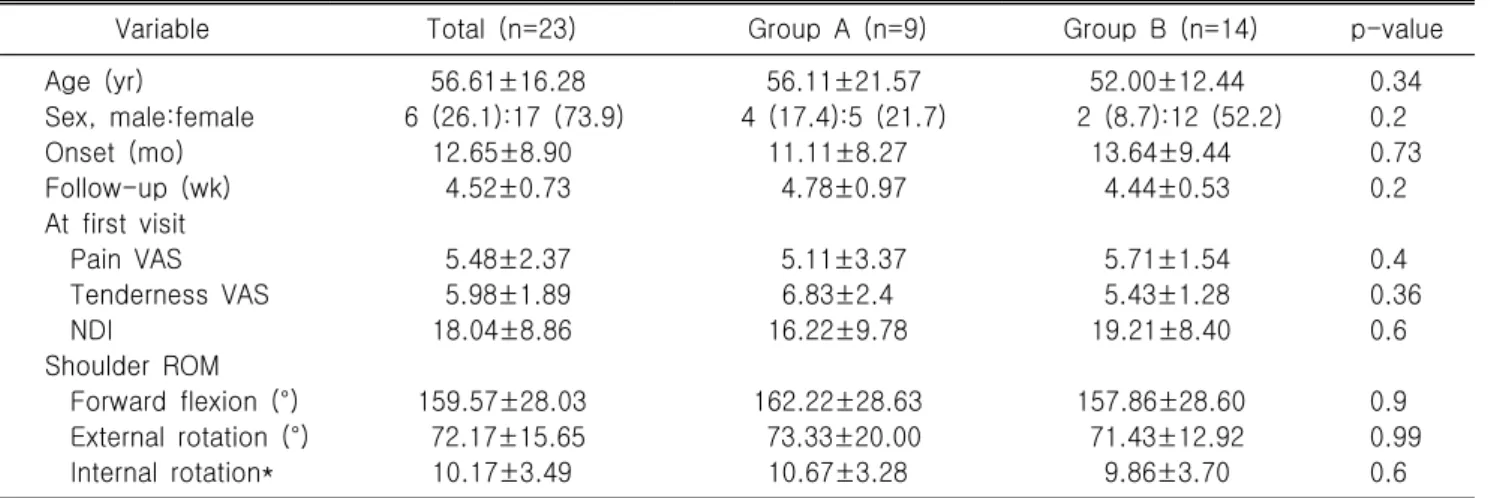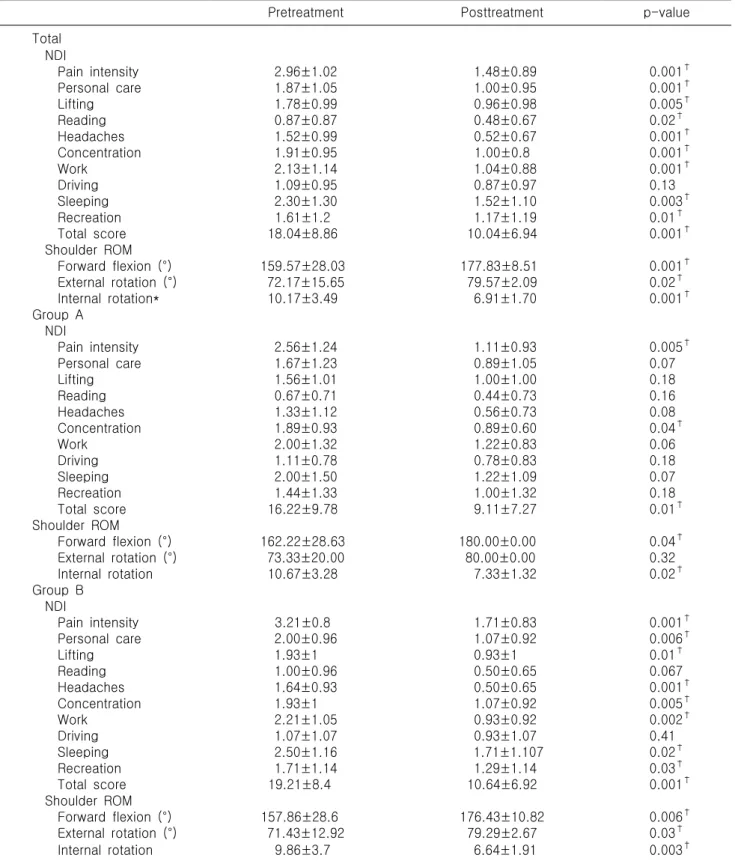Clinical Article
https://doi.org/10.5763/kjsm.2020.38.4.208 pISSN 1226-3729 eISSN 2288-6028
어깨-목 통증증후군에서 체외충격파치료의 효능
210 정형외과
1, 중앙대학교병원 정형외과
2, 경북대학교 의과대학 정형외과
3, 건국대학교병원 정형외과
4김준엽
1 ∙
김재윤2 ∙
윤종필3 ∙
정석원4 ∙
김동현3 ∙
원유선2
Efficacy of Extracorporeal Shock Wave Therapy in Neck and Shoulder Pain Syndrome
Joon Yub Kim 1 , Jae Yoon Kim 2 , Jong Pil Yoon 3 , Seok Won Chung 4 , Dong-Hyun Kim 3 , Yoo-Sun Won 2
1
210 Orthopedics, Seoul,
2Department of Orthopaedic Surgery, Chung-Ang University Hospital, Seoul,
3
Department of Orthopaedic Surgery, School of Medicine, Kyungpook National University, Daegu,
4
Department of Orthopaedic Surgery, Konkuk University Hospital, Seoul, Korea
Purpose: The aim of current study is to verify the efficacy of extracorporeal shock wave therapy (ESWT) in neck and shoulder pain syndrome.
Methods: We enrolled 23 patients with neck and shoulder pain syndrome (mean age, 55±16 years; onset, 12.65±8.90 months) who underwent ESWT from July to December 2019. ESWT (4 to 5 bar or 0.23 –0.45 mJ/mm
2, 1,500 to 2,000 times/region, 7 Hz) was performed at least 4 consecutive times per week. Evaluated outcomes were visual analogue scale (VAS) of pain and tenderness, neck disability index (NDI), and shoulder passive range of motion (ROM; forward flexion [FF], external rotation at neutral [ER], internal rotation at back [IR]). Pain and tenderness VAS scores were assessed at every follow-up, while NDI and shoulder ROM were evaluated two times before treatment and at the final follw-up (at 4.52±0.73 weeks).
Results: The pain VAS score decreased from 5.5±2.4 at first visit to 4.0±1.8 (p=0.001), 3.3±2.1 (p=0.02), and 3.1±2.2 (p=0.29) at the first, second, and third follow-up visits. The tenderness VAS at first visit was 5.98±1.89, which decreased to 5.17±1.83 (p=0.005), 4.61±1.67 (p=0.05), and 4.09±1.92 (p=0.06) at the first, second, and third follow-up visits. NDI was significantly reduced from 18.04±8.86 to 10.04±6.94 at last follow-up (p=0.001) and shoulder ROM was significantly improved after treatment (FF: 159.6°±28.0° to 177.8°±8.5°, p=0.001; ER: 72.2±15.7° to 79.6±2.1°, p=0.02; IR: 10.2±3.49 [T 10] to 6.9±1.7 [T 7], p=0.001).
Conclusion: Consecutive ESWT was effective in treating neck and shoulder pain syndrome with functional improvement and pain reduction. Regarding simultaneous pain and tenderness reduction, receiving ESWT two times per week was effective.
Keywords: Neck, Shoulder, Pain, Extracorporeal shock wave therapy
Received: October 12, 2020 Revised: November 12, 2020 Accepted: November 13, 2020 Correspondence: Jae Yoon Kim
Department of Orthopaedic Surgery, Chung-Ang University Hospital, 102 Heukseok-ro, Dongjak-gu, Seoul 06973, Korea Tel: +82-2-6299-1592, Fax: +82-2-2605-0210, E-mail: kjycje@cau.ac.kr
Copyright ©2020 The Korean Society of Sports Medicine
CC


